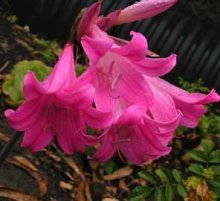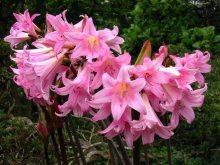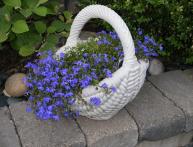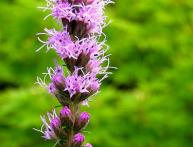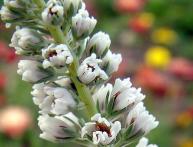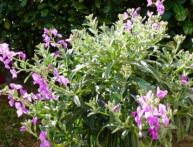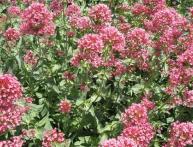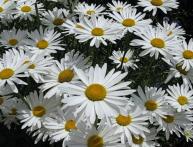Amaryllis belladonna fascinates with its beauty

Amaryllis belladonna is a flower whose roots originate in South and Central America. This plant can often be seen on the islands of the Caribbean.
The flower is capable of producing buds, which later open and can reach 20 cm in diameter.
The main feature of Amaryllis belladonna is its monotypic nature - its family includes only one single species of plant, the lifespan of which can reach several years.
The name Belladonna in translation means Beautiful Lady, but people usually call her “naked”, since leaves grow only during cool weather. Amaryllis can be found in both the subtropics and tropics.
Content:
- Description Amaryllis belladonna
- Secrets of proper care for belladonna
- Reproduction of Amaryllis belladonna
Description Amaryllis belladonna
The flower itself is most often confused with lilies, but these are two completely different groups of plants. Amaryllis belladonna is considered one of the most developed flowers in a biological sense - this is what distinguishes it from the lily family.
This plant consists of several components.
Stem. Its height can reach 60 centimeters, depending on the characteristics of care and climatic conditions. Small dark red dots can most often be found on the trunk.
Buds. The top of the stem consists of a large number of buds, which later open. Pure mature the flower can reach 20 centimeters in diameter, having a bright color around the flower bed.
Inner petals. They give colors more volume and richness. Sepals. Another component of Amaryllis belladonna. This is a kind of external decoration of the plant.
Bulb. The diameter of the lower part of the plant ranges from two to twelve centimeters. The bulb itself can produce up to eight leaves of varying lengths.
Amaryllis belladonna is an excellent decoration for any garden. This is due to the presence of massive and beautiful buds.
Secrets of proper care for belladonna
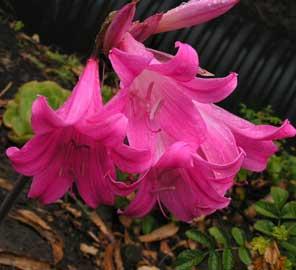
Regular care allows the plant to extend its lifespan and promotes frequent flowering process. Caring for a bulbous plant does not require specific efforts - it is important to simply adhere to certain laws and rules:
Temperature. The thermometer column should not rise above 25 degrees and fall below 18. After the plant has completely gone through the flowering period, it must be moved to a dark place with temperatures not lower than 10 degrees.
Presence of sunlight. Optimal lighting plays a particularly important role, especially during the spring growing season. In other cases, the plant requires bright but diffuse sunlight.
The most suitable place would be a southeast, southwest window or balcony. If this is not possible, you can place the plant on the south side, but the flower must be regularly moved into the shade.
Regular watering. The water must first be settled for a certain time. Watering should be done directly into the soil of the plant, which is located around the bulb. If the flower has finished flowering, watering should be reduced.
Correctly selected soil. For high-quality planting and quick adaptation, a complex of peat and turf soil, which may contain sand or humus, is suitable.
If the plant quickly takes root and took root, this is an indicator that the purchased land is an excellent system for the growth and life of Amaryllis belladonna.
Timely fertilization. This process is recommended to be carried out in the spring. The fertilizer must contain all the minerals necessary for the plant. It is recommended to feed the flower twice, with a break of about 10 days.
A competent approach is very important in caring for plants. Therefore, by studying all the features of the purchased flower, you can extend its life.
Reproduction of Amaryllis belladonna
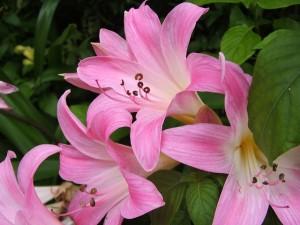
When transplanting the bulbs of this plant, you need to pay attention to the dimensions of the flowerpot. The diameter of the pot should exceed the flower bulb itself by approximately 2 centimeters.
Amaryllis require annual replanting after the bulb breaks dormancy. The process requires careful inspection of the root itself to remove dead excess.
Having discovered small shoots on the bulb, they should be carefully separated and planted in a new place - this is the reproduction system of Amaryllis belladonna.
Propagation of this plant by seed sowing is not excluded. To do this, you need to follow a couple of tips.
Do cross pollination. While at home, you can use a regular brush to pollinate the buds. An indicator of a successful pollination process will be the appearance of a small tricuspid box in which seeds are set within one month.
Sowing. Ripened seeds indicate their readiness for reproduction.Sowing requires sandy-deciduous soil. After the emergence of young plantings, it is recommended to wait for a certain leaf size.
Repeated transplant. After the leaves have reached a length of 10-12 centimeters, they need to be transplanted into small flowerpots.
Plants that have only recently been sown do not require a period of calm and rest.
Bloom. The ability to flower depends on factors such as climate, regular care and proper use of fertilizers. But as a standard, the plant begins to produce buds 2-4 years after proper sowing.
After the flower has been transplanted, you need to actively monitor its condition. Otherwise, the plant may die or lose the ability to open buds.
Amaryllis belladonna, its development and life cycle on video:
Interesting information about the vegetable garden

